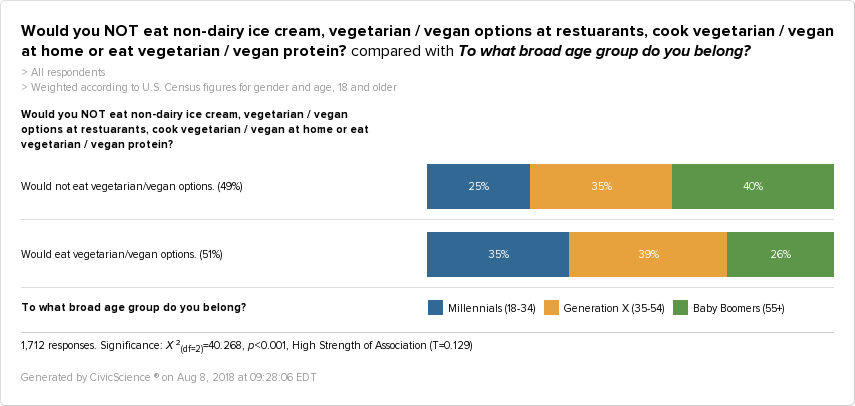In recent years, vegetarianism and veganism have become increasingly mainstream, and a growing portion of grocery stores cater to these formerly fringe dietary interests. With brands like Beyond Meat, Field Roast, Miyoko’s and more debuting vegetarian and vegan products that pride themselves on looking and tasting like their animal-based counterparts, plant-based food sales grew 8.1% from 2016 to 2017.
CivicScience asked 1,712 Americans about their stance on vegetarian and vegan food items and found that just 5% of the adult population identifies as vegetarian/vegan.
This small figure may raise questions as to why and how these lifestyle choices are so visible, given the fact that so few American adults ascribe to these diets. As the data reveals, although only a fraction of the adult population proclaims their vegetarian or vegan status, there is widespread interest in these types of foods.
51% of Americans would eat vegetarian/vegan options, indicating that roughly half of US adults are open to trying foods that are heavily plant-based and, in the case of vegan options, also dairy-free.
The interest in these alternative ways of eating does fall along generational lines.
Individuals from Generation X are the most likely to eat a vegetarian/vegan option, with 39% indicating as such. Millennials are not far behind, at 35%, while Baby Boomers remain in the background with just 26% interested in trying something potentially outside of their normal routine.
Often vegetarian and vegan lifestyles are considered more expensive or less practical than mainstream alternatives. This could be one of the reasons Gen X-ers are the most likely to try a vegetarian/vegan option since they are generally the demographic with the greatest amount of disposable income. Millennials may not have made it to financial abundance just yet, while Baby Boomers may be transitioning to a fixed income.
However, as the data explains, income is not, in fact, as large of a determining factor as may be assumed.
While 40% of those who would not eat a vegetarian/vegan option make less than $50,000 a year, 36% in the same income category would give these options a try. These four percentage points illuminate the fact that, in general, money is not a major obstacle.
When evaluating gender, the divide is clear.
While 60% of those who would eat a vegetarian or vegan option are women, 58% of those who would not are men. This stark contrast speaks to more than just the food options, but the marketing angles used to promote them. In mainstream US advertising, not eating meat or animal products has largely been given a feminine spin, while meat takes a more masculine one. The issue of gendering dietary preferences is a loaded one, and one that might have taken hold of adults across the country.
Another major inhibitor of vegetarian and vegan lifestyles may be protein intake. One of the most common questions that vegetarians and vegans receive is, “Where do you get your protein?” Given the general aversion to vegetarian/vegan protein options, it seems this could keep some interested individuals from giving these lifestyles a try.
25% of US adults would eat a vegetarian/vegan protein option. However, with the rise in popularity of products such as the Impossible Burger, that percentage could be subject to change. After all, vegetarian/vegan protein is having a comeback that could replace the image of dry, tasteless tofu with options that have a greater mass appeal.
Although the percentages of interested individuals are still a minority, when considered in context with the fact that only 5% of respondents are already vegetarian or vegan, the appeal of plant-based options is evident.
Ultimately, consumers may not be interested in a total vegetarian or vegan approach to meals, but a solid half of the population could be ready to incorporate some aspects of a more vegetable-focused lifestyle into their daily routine.
Evidence of this lies in the data below.
30% of US adults would order a vegetarian/vegan item at a restaurant, while 26% would cook a vegetarian/vegan meal at home.
Looking to the future, these individuals are part of the demographic that could be most interested in making vegetarian and vegan options more accessible, not necessarily for their primary type of food, but, at the very least, to enjoy more variety.
















